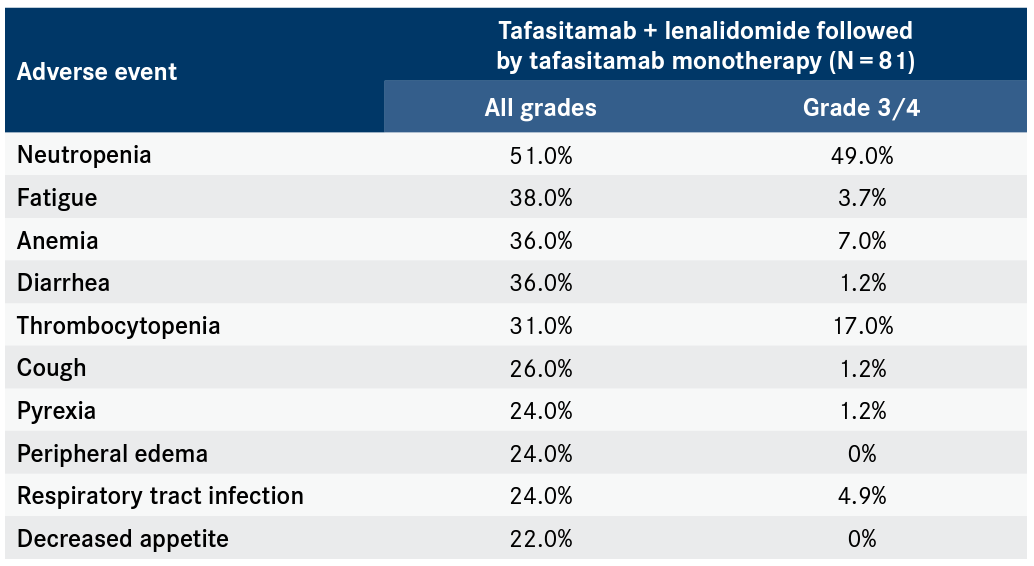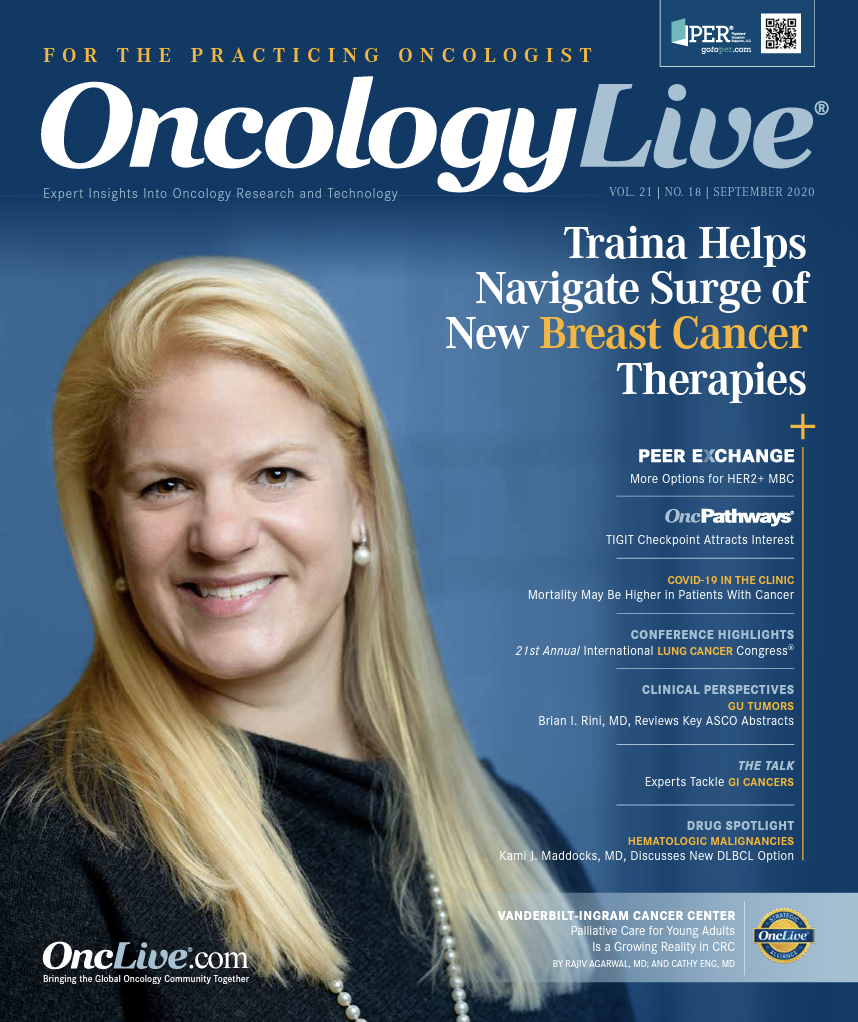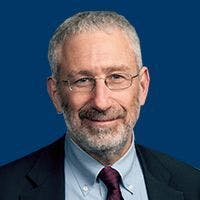Publication
Article
Oncology Live®
Relapsed/Refractory DLBCL Paradigm Gains Chemotherapy-Free Option
Author(s):
Kami J. Maddocks, MD, discusses the tolerability and promise of tafasitamab in combination with lenalidomide in relapsed or refractory DLBCL.
Kami J. Maddocks, MD

Treatment options for patients with relapsed or refractory diffuse large B-cell lymphoma (DLBCL) now include an alternative to chemotherapy. On July 31, 2020, the FDA granted an accelerated approval to tafasitamab-cxix (Monjuvi) in combination with lenalidomide (Revlimid) for adults with relapsed or refractory DLBCL not otherwise specified, including DLBCL arising from low-grade lymphoma, who are not eligible for autologous stem cell transplant.
The regulatory decision was based on efficacy data from the phase 2 L-MIND trial (NCT02399085), which demonstrated a high overall response rate (55%; 95% CI, 43%-67%) and complete response rate (37%) in 71 patients with central pathology-confirmed DLBCL. Tafasitamab plus lenalidomide additionally induced partial responses in 18% of patients, with an acceptable safety profile. The median duration of response was 21.7 months.
In an interview with OncologyLive®, Kami J. Maddocks, MD, a professor of clinical internal medicine in the Division of Hematology at The Ohio State University Comprehensive Cancer Center–Arthur G. James Cancer Hospital and Richard J. Solove Research Institute in Columbus, discussed the regimen’s tolerability and promise for greater efficacy and more durable responses than the combination chemotherapy historically offered in the relapsed or refractory DLBCL second-line setting.
Please describe the patient population for which the combination is indicated and the efficacy data that led to the approval.
Tafasitamab and lenalidomide was studied in patients with relapsed diffuse large B-cell lymphoma who were not candidates for autologous stem cell transplant. This tends to be 2 populations of patients: those who, at their first relapse, are not candidates for autologous stem cell transplant, either because of age or comorbidities, or patients who are receiving salvage chemotherapy with the intent for transplant but do not respond well enough to that treatment to proceed to autologous stem cell transplant.
The combination therapy had an overall response rate of nearly 60% (58.8%) in this population of patients with relapsed diffuse large B-cell lymphoma, including a complete remission rate of a little over 40% (41.3%) [according to data from a long-term analysis of the L-MIND study announced by MorphoSys in May].
These responses proved durable, with a median progression-free survival of 16.2 months and a median duration of response of almost 3 years.
Efficacy Results in the L-MIND Trial

Mechanistically, how do these agents induce their anticancer activity?
These are 2 immunotherapies. Tafasitamab is an antibody to CD19, which is expressed on B cells throughout development, including high expression on malignant B cells, which preserve that expression even after patients received prior therapy. Lenalidomide is an oral immunomodulating agent with activity in a number of lymphomas, including diffuse large B-cell lymphoma. Preclinical data supported the potential synergy of the 2 agents with natural killer cell ADCC [antibody-dependent cellular cytotoxicity] enhanced with the combination of lenalidomide and tafasitamab.
What do we know about the regimen’s tolerability?
When you look at the combination of tafasitamab and lenalidomide, the toxicities that we see are very similar to those with lenalidomide alone. A small number of patients had infusion reactions from tafasitamab, but these were all grade 1 and easily managed. The most common adverse events with the combination were cytopenias— neutropenia, anemia, thrombocytopenia, and febrile neutropenia—and diarrhea, fatigue, and cough, with the most common serious adverse events being infections and febrile neutropenia. The incidence and severity of adverse events did improve in patients who were on tafasitamab monotherapy after 12 cycles of the combination, suggesting that the many, not all, toxicities were attributable to the lenalidomide.
Commonly Reported Adverse Events in the L-MIND Study

This is the first second-line therapy to be OK’d for relapsed DLBCL. What does this combination’s approval mean for the paradigm?
This combination offers a great option for patients who relapsed from diffuse large B-cell lymphoma and are not candidates for autologous stem cell transplant. Prior to this approval and historically, we would typically offer these patients another chemotherapy regimen that was considered palliative and would be associated with many of the same toxicities as initial chemotherapy. This approval gives patients an opportunity to receive a non–chemotherapy- based treatment that appears to be more effective than administering any of these palliative chemotherapy options, with the potential for durable remissions. It also offers a different toxicity profile from that seen with chemotherapy options.
What are the next steps for this regimen?
A phase 1 trial [NCT04134936] evaluated tafasitamab or tafasitamab and lenalidomide in addition to R-CHOP [rituximab, cyclophosphamide, doxorubicin hydrochloride, vincristine sulfate, and prednisone] for the frontline treatment of diffuse large B-cell lymphoma. There is a randomized phase 3 trial planned to evaluate this combination in addition to R-CHOP versus the standard of care, R-CHOP alone.
It is likely to be investigated further in relapsed disease, maybe in other populations of relapsed patients or potentially with other combinations of both chemotherapy and nonchemotherapeutic agents that have activity in diffuse large cell lymphoma.
Reference
- FDA grants accelerated approval to tafasitamab-cxix for diffuse large B-cell lymphoma. FDA. Updated August 3, 2020. Accessed August 29, 2020. https://www.fda.gov/drugs/drug-approvals-and-databases/fda-grants-accelerated-approval-tafasitamab-cxix-diffuse-large-b-cell-lymphoma























%20(2)%201-Recovered-Recovered-Recovered-Recovered-Recovered-Recovered-Recovered-Recovered-Recovered-Recovered-Recovered-Recovered-Recovered-Recovered-Recovered-Recovered-Recovered.jpg?fit=crop&auto=format)
%20(2)%201-Recovered-Recovered-Recovered-Recovered-Recovered-Recovered-Recovered-Recovered-Recovered-Recovered-Recovered-Recovered-Recovered-Recovered-Recovered-Recovered-Recovered.jpg?fit=crop&auto=format)
